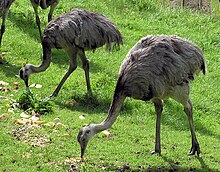Flightless birds are birds that have evolved an inability to fly. There are over 60 extant species including the well known ratites (ostrich, emu, cassowary, rhea and kiwi) and penguins. The largest (both heaviest and tallest) flightless bird, which is also the largest living bird, is the ostrich (2.7 m, 156 kg). Ostriches are farmed for their decorative feathers, meat and their skins, which are used to make leather. Many domesticated birds, such as the domestic chicken and domestic duck, have lost the ability to fly for extended periods, although their ancestral species, the red jungle fowl and mallard respectively, are capable of extended flight. Here in this list Top 10 Amazing Flightless Birds listed, read on:
Penguins (Spheniscidae) are a group of aquatic, flightless birds living almost exclusively in the Southern Hemisphere, especially in Antarctica. Highly adapted for life in the water, penguins have counter shaded dark and white plumage, and their wings have evolved into flippers. Most penguins feed on krill, fish, squid and other forms of sea-life caught while swimming underwater. They spend about half of their lives on land and half in the oceans.
2. Ostrich
The ostrich (Struthio camelus) is either one or two species of large flightless birds native to Africa, the only living member of the genus Struthio, which is in the ratite family. The ostrich shares the order Struthioniformes with the kiwis, emus, rheas and cassowaries. However, phylogenetic studies have shown that it is the basal extant member of Palaeognathae and is thus equally closely related to flighted tinamous. It is distinctive in its appearance, with a long neck and legs, and can run at up to about 70 km/h (19 m/s; 43 mph), the fastest land speed of any bird. The ostrich is the largest living species of bird and lays the largest eggs of any living bird.
3. Emu
The emu (Dromaius novaehollandiae) is the second-largest living bird by height, after its ratite relative, the ostrich. It is endemic to Australia where it is the largest native bird and the only extant member of the genus Dromaius. Emus are soft-feathered, brown, flightless birds with long necks and legs, and can reach up to 1.9 metres (6.2 ft) in height. Emus can travel great distances, and when necessary can sprint at 50 km/h (30 mph); they forage for a variety of plants and insects, but have been known to go for weeks without eating. They drink infrequently, but take in copious amounts of water when the opportunity arises.
4. Kiwi
Kiwi or kiwis are flightless birds native to New Zealand (Apterygidae). At around the size of a domestic chicken, kiwi are by far the smallest living ratites (which also consist of ostriches, emus, rheas, and cassowaries), and lay the largest egg in relation to their body size of any species of bird in the world. There are five recognized species, two of which are currently vulnerable, one of which is endangered, and one of which is critically endangered. All species have been negatively affected by historic deforestation but currently the remaining large areas of their forest habitat are well protected in reserves and national parks. At present, the greatest threat to their survival is predation by invasive mammalian predators. The kiwi is a national symbol of New Zealand.
5. Cassowary
The cassowaries are ratites in the genus Casuarius and are native to the tropical forests of New Guinea nearby islands, and northeastern Australia. There are three extant species. The most common of these, the southern cassowary, is the third tallest and second heaviest living bird, smaller only than the ostrich and emu. Cassowaries feed mainly on fruit, although all species are truly omnivorous and will take a range of other plant food, including shoots and grass seeds, in addition to fungi, invertebrates, and small vertebrates. Cassowaries are very shy, but when provoked they are capable of inflicting injuries, occasionally fatal, to dogs and people.
6. Moa
The moa were nine species (in six genera) of flightless birds endemic to New Zealand. The two largest species, Dinornis robustus and Dinornis novaezelandiae, reached about 3.6 m (12 ft) in height with neck outstretched, and weighed about 230 kg (510 lb). When Polynesians settled New Zealand around CE 1280, the moa population was about 58,000. Moa belong to the order Dinornithiformes, traditionally placed in the ratite group. The nine species of moa were the only wingless birds, lacking even the vestigial wings which all other ratites have. They were the dominant herbivores in New Zealand's forest, shrubland and subalpine ecosystems for thousands of years, and until the arrival of the Māori were hunted only by the Haast's eagle. Moa extinction occurred in CE 1440 ± 20 years, primarily due to overhunting by Māori.
7. Elephant Birds
Elephant birds are members of the extinct family Aepyornithidae. Elephant birds were large to enormous flightless birds that once lived on the island of Madagascar. They became extinct, probably in the 17th or 18th century, for reasons that are unclear, although human activity is the suspected cause. Elephant birds comprised the genera Mullerornis and Aepyornis. Aepyornis was among the heaviest of birds. While they were in close geographical proximity to the ostrich, elephant birds' closest living relatives are kiwis, suggesting that ratites did not diversify by vicariance during the breakup of Gondwana but instead evolved from ancestors that dispersed more recently by flying.
8. Inaccessible Island rail
The Inaccessible Island rail (Atlantisia rogersi) is a small bird of the rail family, Rallidae. It is the only species in its genus. It is found only on Inaccessible Island in the Tristan Archipelago, and is notable for being the smallest extant flightless bird in the world. Unlike many other islands, Inaccessible Island has remained free from introduced predators, allowing this species to flourish while many other flightless birds, including the even smaller Stephens Island wren, have perished.
9. Falkland steamer duck
The Falkland steamer duck (Tachyeres brachypterus) is a steamer duck native to the Falkland Islands in the southern Atlantic Ocean. It is one of only two bird species to be endemic to the Falkland Islands, the other being Cobb's wren. Description The Falkland steamer duck's wings are very short and it is incapable of flight. The plumage of the Falkland steamer duck is mostly dark grey, but with a white stripe behind the eye. It is very difficult to distinguish from the flying steamer duck in the field since they occupy the same habitat and, although the flying steamer duck can fly, it rarely does.
10. Rhea
The rheas large ratites (flightless birds without a keel on their sternum bone) in the order Rheiformes, native to South America, related to the ostrich and emu. There are two extant species: the greater or American rhea (Rhea americana) and the lesser or Darwin's rhea (Rhea pennata). Both are currently rated as near-threatened in their native ranges; a feral population of the greater rhea in Germany appears to be growing.
So what you think about this list don't forget to mention :)
Top 10 Amazing Flightless Birds in the World
1. PenguinPenguins (Spheniscidae) are a group of aquatic, flightless birds living almost exclusively in the Southern Hemisphere, especially in Antarctica. Highly adapted for life in the water, penguins have counter shaded dark and white plumage, and their wings have evolved into flippers. Most penguins feed on krill, fish, squid and other forms of sea-life caught while swimming underwater. They spend about half of their lives on land and half in the oceans.
2. Ostrich
The ostrich (Struthio camelus) is either one or two species of large flightless birds native to Africa, the only living member of the genus Struthio, which is in the ratite family. The ostrich shares the order Struthioniformes with the kiwis, emus, rheas and cassowaries. However, phylogenetic studies have shown that it is the basal extant member of Palaeognathae and is thus equally closely related to flighted tinamous. It is distinctive in its appearance, with a long neck and legs, and can run at up to about 70 km/h (19 m/s; 43 mph), the fastest land speed of any bird. The ostrich is the largest living species of bird and lays the largest eggs of any living bird.
3. Emu
The emu (Dromaius novaehollandiae) is the second-largest living bird by height, after its ratite relative, the ostrich. It is endemic to Australia where it is the largest native bird and the only extant member of the genus Dromaius. Emus are soft-feathered, brown, flightless birds with long necks and legs, and can reach up to 1.9 metres (6.2 ft) in height. Emus can travel great distances, and when necessary can sprint at 50 km/h (30 mph); they forage for a variety of plants and insects, but have been known to go for weeks without eating. They drink infrequently, but take in copious amounts of water when the opportunity arises.
4. Kiwi
Kiwi or kiwis are flightless birds native to New Zealand (Apterygidae). At around the size of a domestic chicken, kiwi are by far the smallest living ratites (which also consist of ostriches, emus, rheas, and cassowaries), and lay the largest egg in relation to their body size of any species of bird in the world. There are five recognized species, two of which are currently vulnerable, one of which is endangered, and one of which is critically endangered. All species have been negatively affected by historic deforestation but currently the remaining large areas of their forest habitat are well protected in reserves and national parks. At present, the greatest threat to their survival is predation by invasive mammalian predators. The kiwi is a national symbol of New Zealand.
5. Cassowary
The cassowaries are ratites in the genus Casuarius and are native to the tropical forests of New Guinea nearby islands, and northeastern Australia. There are three extant species. The most common of these, the southern cassowary, is the third tallest and second heaviest living bird, smaller only than the ostrich and emu. Cassowaries feed mainly on fruit, although all species are truly omnivorous and will take a range of other plant food, including shoots and grass seeds, in addition to fungi, invertebrates, and small vertebrates. Cassowaries are very shy, but when provoked they are capable of inflicting injuries, occasionally fatal, to dogs and people.
6. Moa
The moa were nine species (in six genera) of flightless birds endemic to New Zealand. The two largest species, Dinornis robustus and Dinornis novaezelandiae, reached about 3.6 m (12 ft) in height with neck outstretched, and weighed about 230 kg (510 lb). When Polynesians settled New Zealand around CE 1280, the moa population was about 58,000. Moa belong to the order Dinornithiformes, traditionally placed in the ratite group. The nine species of moa were the only wingless birds, lacking even the vestigial wings which all other ratites have. They were the dominant herbivores in New Zealand's forest, shrubland and subalpine ecosystems for thousands of years, and until the arrival of the Māori were hunted only by the Haast's eagle. Moa extinction occurred in CE 1440 ± 20 years, primarily due to overhunting by Māori.
7. Elephant Birds
Elephant birds are members of the extinct family Aepyornithidae. Elephant birds were large to enormous flightless birds that once lived on the island of Madagascar. They became extinct, probably in the 17th or 18th century, for reasons that are unclear, although human activity is the suspected cause. Elephant birds comprised the genera Mullerornis and Aepyornis. Aepyornis was among the heaviest of birds. While they were in close geographical proximity to the ostrich, elephant birds' closest living relatives are kiwis, suggesting that ratites did not diversify by vicariance during the breakup of Gondwana but instead evolved from ancestors that dispersed more recently by flying.
8. Inaccessible Island rail
The Inaccessible Island rail (Atlantisia rogersi) is a small bird of the rail family, Rallidae. It is the only species in its genus. It is found only on Inaccessible Island in the Tristan Archipelago, and is notable for being the smallest extant flightless bird in the world. Unlike many other islands, Inaccessible Island has remained free from introduced predators, allowing this species to flourish while many other flightless birds, including the even smaller Stephens Island wren, have perished.
9. Falkland steamer duck
The Falkland steamer duck (Tachyeres brachypterus) is a steamer duck native to the Falkland Islands in the southern Atlantic Ocean. It is one of only two bird species to be endemic to the Falkland Islands, the other being Cobb's wren. Description The Falkland steamer duck's wings are very short and it is incapable of flight. The plumage of the Falkland steamer duck is mostly dark grey, but with a white stripe behind the eye. It is very difficult to distinguish from the flying steamer duck in the field since they occupy the same habitat and, although the flying steamer duck can fly, it rarely does.
10. Rhea
The rheas large ratites (flightless birds without a keel on their sternum bone) in the order Rheiformes, native to South America, related to the ostrich and emu. There are two extant species: the greater or American rhea (Rhea americana) and the lesser or Darwin's rhea (Rhea pennata). Both are currently rated as near-threatened in their native ranges; a feral population of the greater rhea in Germany appears to be growing.
So what you think about this list don't forget to mention :)

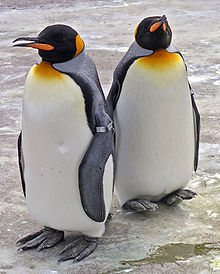
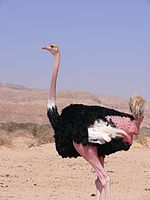

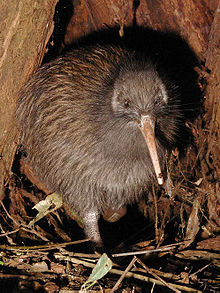
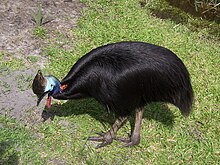
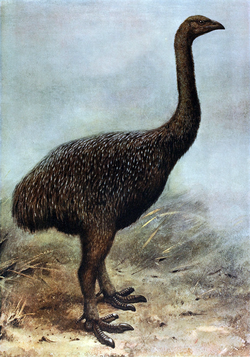

.jpg/220px-Inaccessible_Island_Rail_(Atlantisia_rogersi).jpg)

